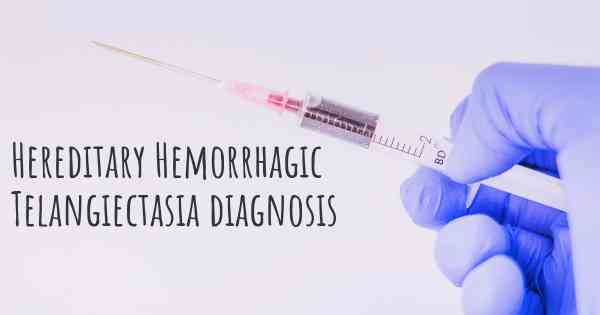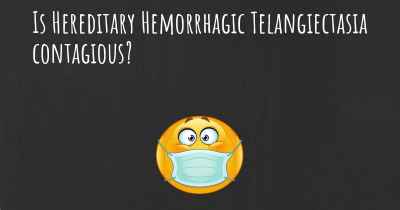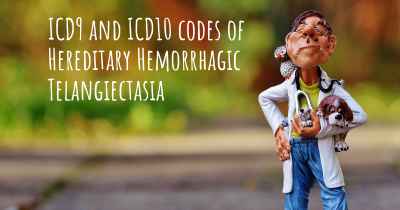How is Hereditary Hemorrhagic Telangiectasia diagnosed?
See how Hereditary Hemorrhagic Telangiectasia is diagnosed. Which specialists are essential to meet, what tests are needed and other useful information for the diagnosis of Hereditary Hemorrhagic Telangiectasia

Diagnosis of Hereditary Hemorrhagic Telangiectasia (HHT)
Hereditary Hemorrhagic Telangiectasia (HHT), also known as Osler-Weber-Rendu syndrome, is a rare genetic disorder that affects blood vessels. It is characterized by the development of abnormal blood vessels called telangiectasias, which are fragile and prone to bleeding. HHT can affect various organs, including the nose, lungs, brain, and gastrointestinal tract.
Signs and Symptoms
The signs and symptoms of HHT can vary widely between individuals, even within the same family. Some common manifestations include:
- Nosebleeds (epistaxis): Recurrent and spontaneous nosebleeds are often the earliest and most common symptom of HHT.
- Telangiectasias: These are small, dilated blood vessels that appear as red or purple spots on the skin or mucous membranes. They can be found on the face, lips, tongue, fingers, and other areas.
- Arteriovenous malformations (AVMs): These are abnormal connections between arteries and veins that bypass the capillary system. AVMs can occur in various organs, such as the lungs, liver, brain, and spine.
- Organ-specific symptoms: Depending on the location of AVMs, individuals with HHT may experience symptoms related to the affected organ. For example, pulmonary AVMs can cause shortness of breath, chest pain, and stroke-like symptoms if they allow abnormal blood flow to the brain.
Diagnostic Criteria
Diagnosing HHT involves a combination of clinical evaluation, family history assessment, and specific diagnostic tests. The diagnostic criteria for HHT, as established by the International HHT Guidelines, include:
- Epistaxis: Recurrent nosebleeds, typically starting before the age of 10.
- Telangiectasias: Multiple telangiectasias on characteristic locations, such as the lips, oral cavity, fingers, or nose.
- Visceral AVMs: Presence of AVMs in one or more internal organs, confirmed by imaging studies.
- Family history: A first-degree relative (parent, sibling, or child) with a confirmed diagnosis of HHT based on the above criteria.
Diagnostic Tests
Several diagnostic tests can be used to confirm the presence of HHT and assess its severity:
- Nasal endoscopy: A visual examination of the nasal passages and mucous membranes using a thin, flexible tube with a camera. This helps identify telangiectasias and assess the severity of nosebleeds.
- Imaging studies: Various imaging techniques can be used to detect AVMs in different organs. These may include:
- Computed tomography (CT) scan: Provides detailed cross-sectional images of the body, allowing the identification of AVMs in the lungs, liver, or brain.
- Magnetic resonance imaging (MRI): Uses powerful magnets and radio waves to produce detailed images of organs and tissues. It is particularly useful for detecting brain AVMs.
- Echocardiography: An ultrasound examination of the heart to evaluate the presence of AVMs or other abnormalities.
- Angiography: Invasive procedure where a contrast dye is injected into blood vessels, followed by X-rays to visualize the blood flow and identify AVMs.
- Genetic testing: HHT is primarily caused by mutations in certain genes, such as ENG, ACVRL1, and SMAD4. Genetic testing can identify these mutations and confirm the diagnosis of HHT, especially in individuals who do not meet all the clinical criteria.
Management and Treatment
Once a diagnosis of HHT is confirmed, appropriate management strategies can be implemented. The goals of treatment include:
- Preventing and controlling bleeding: Various interventions can be used to manage nosebleeds, such as nasal moisturizers, cauterization, laser therapy, and, in severe cases, embolization of nasal blood vessels.
- Treating complications: Specific treatments may be required for complications related to AVMs, such as embolization or surgical removal of AVMs in the lungs or brain.
- Screening and surveillance: Regular monitoring of affected individuals is crucial to detect and manage potential complications. This may involve periodic imaging studies, echocardiograms, and other tests depending on the organs involved.
- Genetic counseling: Individuals with HHT and their families may benefit from genetic counseling to understand the inheritance pattern, assess the risk of passing on the condition to offspring, and discuss family planning options.
In conclusion, the diagnosis of Hereditary Hemorrhagic Telangiectasia (HHT) involves a comprehensive evaluation of clinical signs, family history, and specific diagnostic tests. The presence of recurrent nosebleeds, multiple telangiectasias, visceral AVMs, and a positive family history are key criteria for diagnosing HHT. Diagnostic tests, such as nasal endoscopy, imaging studies, and genetic testing, help confirm the diagnosis and assess the severity of the condition. Once diagnosed, appropriate management strategies can be implemented to prevent bleeding, treat complications, and provide regular surveillance to individuals with HHT.
On the other hand there is a test genetic
Posted Mar 9, 2017 by Rosario Figueroa 2770








